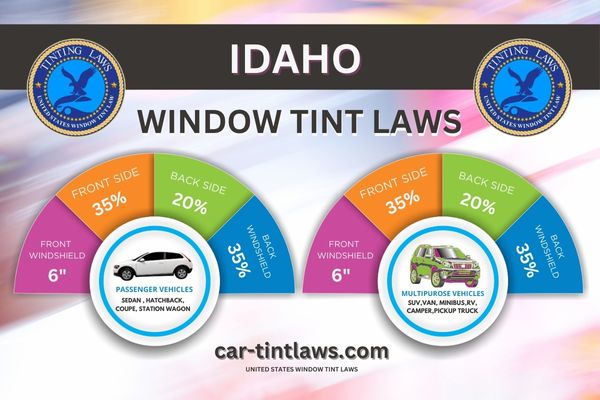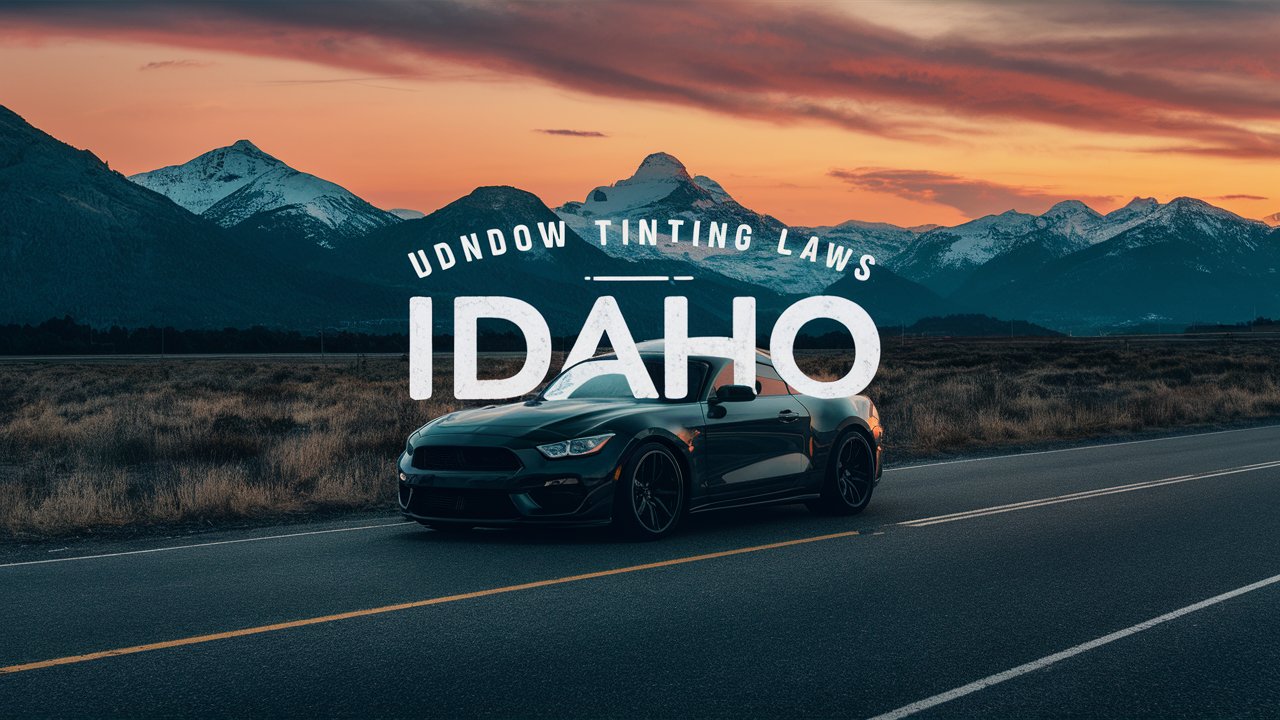Imagine driving through Idaho’s sunlit valleys, your car windows tinted just right to keep the glare at bay.
If you’re thinking about tinting your windows, you’ll need to navigate Idaho’s specific laws concerning the darkness and reflectivity of your tints.
These regulations vary depending on whether you drive a sedan or an SUV/van, and improper tinting can result in fines.
Did you know there are also medical exemptions that allow for darker tints?
Understanding these laws can guarantee you stay compliant and avoid penalties. Let’s explore the details you need to know.
Window Tint Darkness in Idaho
When it comes to window tint darkness in Idaho, you need to know the specific requirements for different types of vehicles.
For sedans, front side windows must allow more than 35% light transmission, while the same percentage applies to the rear windows.
In contrast, SUVs and vans have a slightly different rule for back side windows, which must allow more than 20% light transmission, but their rear windows must also adhere to the 35% light transmission standard.
Tint darkness for sedans:
- Windshield: Non-reflective tint is allowed on the top 6 inches of the windshield.
- Front Side windows: Must allow more than 35% of light in.
- Back Side windows: Must allow more than 20% of light in.
- Rear Window: Must allow more than 35% of light in.
Tint darkness for SUV and Vans:
- Windshield: Non-reflective tint is allowed on the top 6 inches of the windshield.
- Front Side windows: Must allow more than 35% of light in.
- Back Side windows: Must allow more than 20% of light in.
- Rear window: Must allow more than 35% of light in.
Window Tint Reflection in Idaho
When it comes to window tint reflection in Idaho, you’ll need to know the specific limits for different vehicle types.
For sedans, both front side and back side windows must not reflect more than 35% of light.
Similarly, SUVs and vans are required to keep their front side and back side window reflection at or below 35%, ensuring compliance with state regulations.
Tint reflection for sedans:
- Front Side windows: Must not be more than 35% reflective.
- Back Side windows: Must not be more than 35% reflective.
Tint reflection for SUV and vans:
- Front Side windows: Must not exceed 35% reflection.
- Back Side windows: Must not exceed 35% reflection.
Other Idaho window tint rules and regulations
- Side Mirrors: No restrictions.
- Restricted Colors: In Idaho, all tint colors are permitted.
- Certificates: Manufacturers of film need to certify the film they sell in the state. Ask your dealer if they are using certified film.
- Stickers: The sticker/label of compliance to identify legal tinting is required between the film & glass on each tinted window.
- Medical Exceptions: Idaho permits medical exemptions for special tint. For more details about the specific terms of the exemption, consult Idaho state law.
- Penalties: Violating Idaho’s window tint laws can result in a traffic infraction with fines.

Medical Exemptions for Window Tint Rules in Idaho
If you have a medical condition requiring additional sun protection, Idaho’s window tinting laws offer exemptions allowing for darker tints with proper medical documentation.
These medical exemptions permit window tint as dark as 20% VLT, provided you have written verification from a licensed physician.
This is particularly relevant for individuals with specific skin or eye health conditions needing extra protection from sunlight.
Front side windows and windshields are areas where these medical exemptions for tint darkness can be applied.
Idaho’s window tint laws recognize the necessity for some individuals to have darker tints due to medical needs while still adhering to the state’s regulations.
To benefit from these exemptions, you must obtain a detailed note from your licensed physician, specifying the medical condition that warrants the need for darker window tint.
This written verification must clearly state why increased sun protection is medically necessary for you.
By following these guidelines, you’ll be able to use darker window tints legally, ensuring both your health and compliance with Idaho’s window tint standards.
This balance aims to accommodate your medical needs while maintaining public safety on the roads.
Idaho Window Tint Ticket Cost
While following Idaho’s window tinting regulations, it’s crucial to understand that a violation can lead to a $67 fine, classified as a traffic infraction.
If you’re caught with illegal tint, both you as the driver and the tint installer can be held accountable.
Idaho window tint violations are taken seriously, so comprehending the specific rules regarding light transmission levels and reflectivity ratings is vital.
For example, the Idaho State Police enforce these regulations, making certain that your tint meets the required standards.
If your vehicle’s tint doesn’t comply, you’ll face the traffic infraction fine. Light transmission levels indicate the amount of light that passes through your window, while reflectivity ratings gauge how much light the tint reflects.
Both components must adhere to Idaho’s legal standards.
There are medical exemptions available if a licensed physician provides written verification that you require a specific tint for health reasons.
It’s crucial to keep this documentation in your vehicle. Staying informed and compliant can prevent you from unnecessary fines and hassles.
Always make sure that your tint installer is aware of Idaho’s laws to steer clear of Idaho window tint violations.
Idaho Climate Considerations
Given Idaho’s scorching summers and high UV index, window tinting provides substantial advantages for sun protection and heat reduction effectiveness.
It aids in maintaining cooler vehicle interiors, lessening the burden on air conditioning systems.
Furthermore, while window tinting can enhance driving visibility by decreasing glare in summer, it is crucial to take into account its effect on visibility during Idaho’s winter months.
Sun Protection Benefits
Idaho’s sunny climate makes sun protection essential for vehicle occupants, and window tinting offers an effective way to reduce UV exposure and heat buildup in your car.
By investing in Idaho Window Tint, you’re not only protecting your skin from harmful UV rays but also ensuring a more comfortable interior temperature.
It’s important to understand the laws in Idaho regarding window tinting to stay compliant while enjoying the sun protection benefits.
Tinted windows can notably reduce glare, making it easier and safer to drive under Idaho’s bright sun.
The regulations in Idaho specify the permissible level of tint on different windows of your vehicle.
By adhering to these regulations, you can enjoy the benefits of reducing UV exposure and minimizing heat buildup without falling afoul of the law.
Moreover, window tinting helps prevent skin damage that can result from prolonged sun exposure, which is a common concern for Idaho residents.
Being mindful of these regulations not only keeps you compliant but also enhances your driving experience.
Understanding the sun protection benefits of window tinting allows you to make informed decisions, ensuring both comfort and safety for you and your passengers.
Heat Reduction Efficiency
With Idaho’s hot summers, efficient heat reduction becomes vital for maintaining vehicle comfort.
Window tinting can greatly lower interior temperatures during Idaho’s warm weather.
By applying tinting film to your vehicle’s windows, you can block a substantial amount of UV rays and heat, enhancing the cooling efficiency of your air conditioning system.
This not only makes your driving experience more comfortable but also contributes to better fuel efficiency by reducing the need for constant air conditioning.
Idaho tint regulations allow for a certain level of window tinting, which can make a notable difference in heat reduction.
The film used in window tinting acts as a barrier, minimizing the amount of heat that transfers into your vehicle.
This heat reduction efficiency is essential for those long summer drives, ensuring that you and your passengers remain cool and comfortable.
Understanding and adhering to Idaho tint regulations ensures that you can enjoy these benefits without legal complications.
By reducing heat buildup inside your vehicle, window tinting not only improves comfort but also extends the life of your car’s interior by protecting it from sun damage.
Hence, considering window tinting is a wise choice for Idaho residents.
Winter Visibility Impact
Driving through Idaho’s winter roads with tinted windows can pose visibility challenges due to snow, ice, and shorter daylight hours.
Snow accumulation on your tinted windows can obstruct visibility, making it difficult to see clearly.
Ice formation on windows can also distort your view, affecting the performance of the nonreflective window tinting film.
Reduced daylight during winter months further compounds these issues by making it harder to see through heavily tinted windows, especially during early mornings and late afternoons.
To guarantee safety, your front side vents must allow a certain level of visibility.
It’s essential that your immediate right and left views remain unobstructed to navigate safely through winter conditions.
The rear windows can have nonreflective tinting, but they must also maintain a balance between privacy and visibility.
Idaho law mandates that window tints must meet specific luminous reflectance standards to secure that your view is not excessively darkened, preventing unnecessary risks on icy, snow-covered roads.
References
Frequently Asked Questions
What Is the Darkest Legal Tint in Idaho?
You’re wondering about the darkest legal tint in Idaho? For sedans and SUVs/vans, front side windows need over 35% tint percentage for tint visibility.
Tint inspection guarantees compliance, avoiding tint fines and tint tickets, prioritizing tint safety.
Can You Get Pulled Over for Window Tint in Idaho?
Yes, you can get pulled over for window tint in Idaho. Police enforcement will issue a tint ticket if your tint exceeds the legal limit.
Tint fines and potential tint removal guarantee safety concerns are addressed through tint inspection.
How to Get Tint Exemption in Idaho?
To get a tint exemption in Idaho, you’ll need medical exemptions. The process requires documentation from a licensed physician, vehicle inspections, and adherence to legal limits.
Be aware of penalties for violations and law enforcement discretion.
Which State Has the Darkest Tint Law?
Imagine a veil of secrecy on your windows. When comparing state tint percentages,
California allows some of the darkest tints. Safety concerns, privacy benefits, UV protection, and legal consequences all play roles in tint installation decisions.
Conclusion
Grasping Idaho’s window tinting laws is crucial for compliance and safety. Are you ready to modify your tint to meet legal standards?
By following regulations on tint darkness and reflectivity, and being mindful of medical exemptions, you help promote safer driving conditions.
Always refer to Idaho State Police guidelines and stay updated about any revisions to the laws.
Adhering to these rules helps prevent fines, guaranteeing you drive legally and responsibly.
